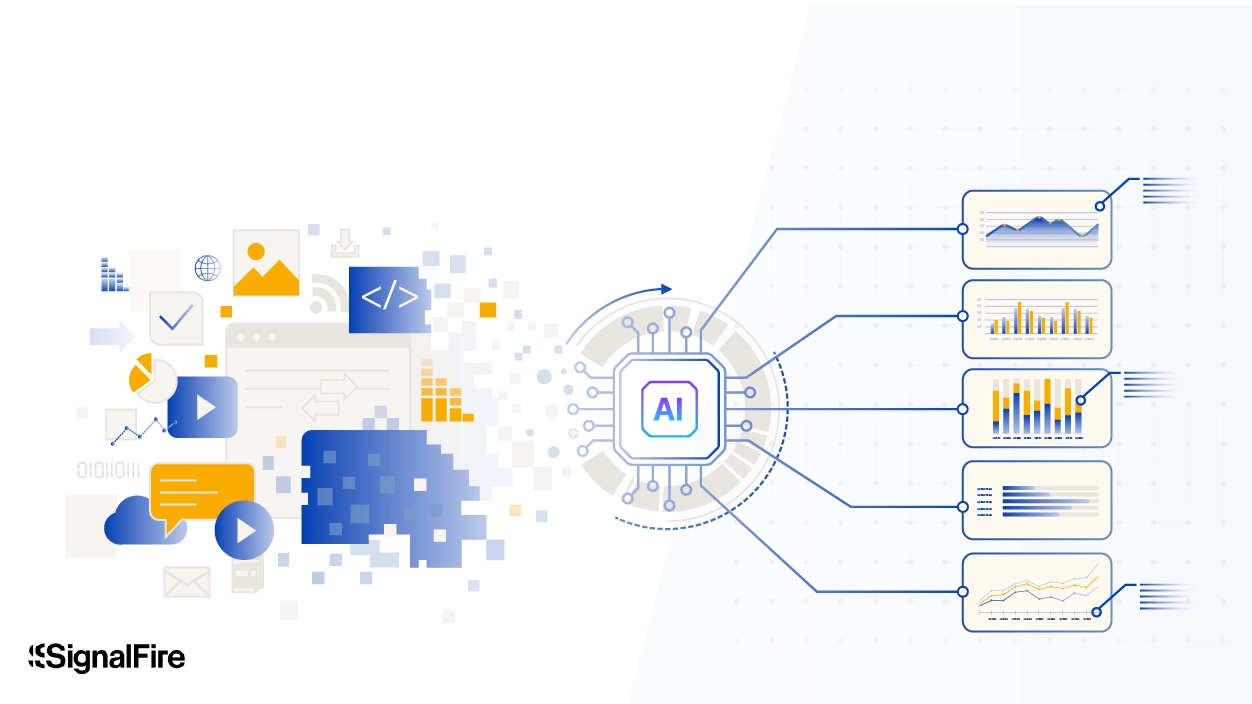
The next era of enterprise software will be defined by solving problems, not selling tools. SaaS has become mainstream. The low-hanging fruit for workflow software has been picked. It will take a new approach to modernize the remaining tech-laggard industries such as healthcare, education, and manufacturing/industrials. These historically challenged industries—they often suffer extremely thin or non-existent IT budgets, bureaucratic procurement processes, and non-economic rational behavior—need more than just a dedicated software replacement for spreadsheets and email.
SignalFire believes the model will be AI-powered services with usage or performance-based business models. Here, the convergence of data proliferation and AI will unlock new end-to-end automations that aren’t priced by the month or seat, but by the business impact they drive.
Historically, an AI company might build data ingestion pipelines and leverage the “read” capabilities of AI to package data/insights together in a piece of software, which they would need to sell into shallow IT budgets with often murky ROI measurement. For example, within litigation, this could mean ingesting data across employer documents, police reports, medical billing statements, physician notes, and more to make recommendations.
But AI companies can now combine this traditional machine learning with the new “write” capabilities of generative AI to fully automate the entirety of the work output, like a court filing or insurance submission, end to end. This lets these startups tap into labor expenses, which constitute 80–90% of the cost structure for many of these legacy industries like law.
It’s hard to understate how radical of a shift this is. We’ve been blown away seeing it firsthand.
SignalFire portfolio company EvenUp automates the laborious process of researching and writing hundred-page demand generation letters end to end. As a result of providing this cheaper, faster, and better, they can monetize personal injury law firms to the tune of many tens of thousands per lawyer in many cases. In contrast, core case management software systems of record sell for $1–2K per lawyer.
Instead of providing a SaaS tool that requires armies of paralegals to wield, EvenUp solves the demand letter problem entirely.
But building a generative AI–native solution in this way is by no means easy—and requires a very different product and company orientation—which presents massive opportunities for new entrants.
To be clear, a copilot software will be valuable for some extremely complex tasks that require a frequent human touch. They can certainly make software engineers more efficient, but that doesn’t solve the problem. That’s why the real potential to change the game with AI means going from:
- Copilot to control center for “AI employees”
- UX for workers to UX for managers one layer higher in the organization
- Seat add-on software model to a labor based pricing model
- SLA on uptime/function to uptime on outcomes (e.g., efficiency, qualified, revenue, ROI)
- Unlocking entirely new use cases in services, by combining read and write technical capabilities only now becoming possible
- Graduating from small/uncertain IT budget to labor budgets that can comprise 80–90% of SMB/service firm cost structure
 |
By virtue of unlocking a different and much deeper monetizing business model that cuts services/labor costs that are often 10x greater than software budgets, AI-enabled SaaS businesses will unlock a long tail of SMB verticals that are now economically viable when 10-person companies represent $500K in annual contract value instead of $10K in SaaS spend.
Further, these AI-enabled SaaS businesses can take their service offering and break it up into discrete product offerings that can be sold into different segments of the market, deepening monetization and building even more dominant share within their respective verticals.
Finally, since many of these businesses will be driven by vertical-specific datasets as their moat, they’ll define a new playbook for data acquisition in parallel with their revenue-generating go-to-market motion in a virtuous data cycle: the more users, the more data, the better the product and the more users can be acquired profitably.
While these playbooks are still being written as we speak, this AI-enabled SaaS model has the potential to 10x the size of the SaaS revolution.
*Portfolio company founders listed above have not received any compensation for this feedback and may or may not have invested in a SignalFire fund. These founders may or may not serve as Affiliate Advisors, Retained Advisors, or consultants to provide their expertise on a formal or ad hoc basis. They are not employed by SignalFire and do not provide investment advisory services to clients on behalf of SignalFire. Please refer to our disclosures page for additional disclosures.
Related posts

The built economy: How vertical AI is unlocking the biggest untapped market in trades and construction

Why expert data is becoming the new fuel for AI models

